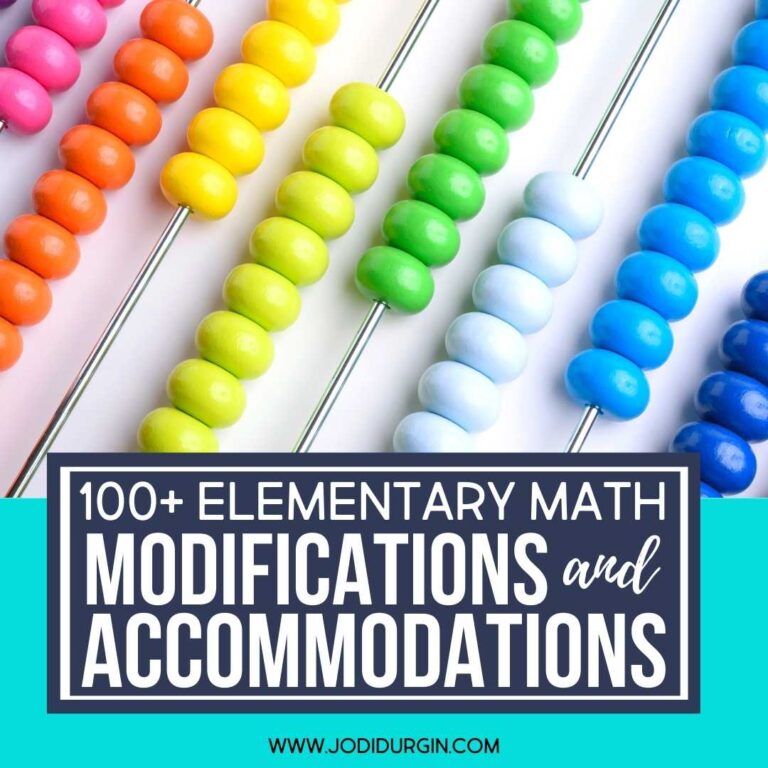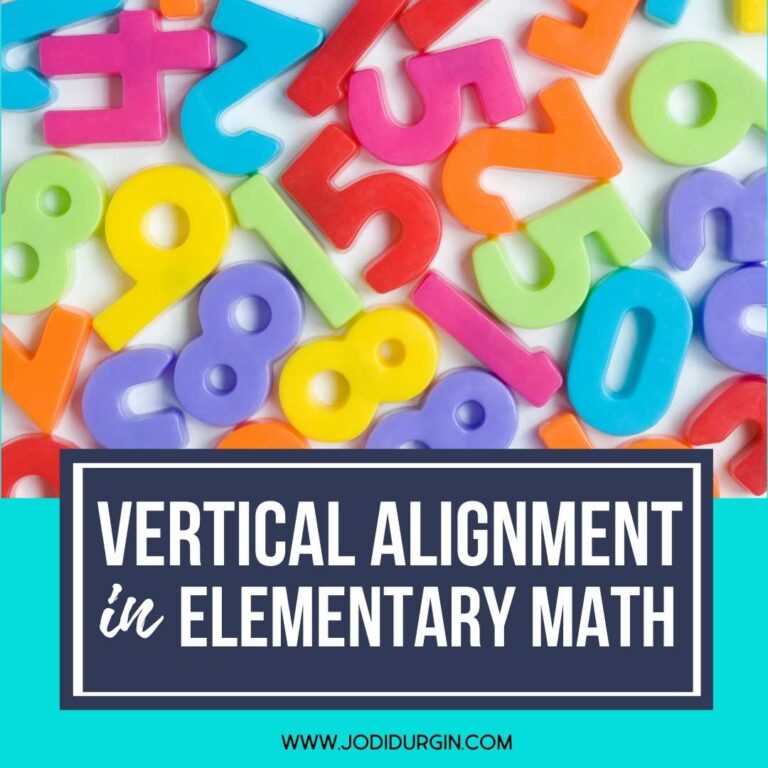If you are looking for tips and ideas for how to teach word problems to your elementary students, then you’ve found the right place! We know that teaching elementary students how to solve word problems is important for math concept and skill application, but it sure can feel like a daunting charge without knowing about the different types, the best practices for teaching them, and common misconceptions to plan in advance for, as well as having the resources you need. All this information will make you feel confident about how to teach addition, subtraction, multiplication, and division word problems! Teaching students how to solve word problems will be so much easier!
This blog post will address the following questions:
- What is a word problem?
- What is a multi-step word problem?
- Why are elementary math word problems important?
- Why are math word problems so hard for elementary students?
- What are the types of word problems?
- How do I teach math word problems in a systematic way?
- What are the best elementary math word problem strategies I can teach my students and what are some tips for how to teach math word problems strategies?
- Do you have any helpful tips for how to teach word problems?
- What are the common mistakes I should look for that my students may make?
- How do I address my students’ common misconceptions surrounding elementary math word problems?
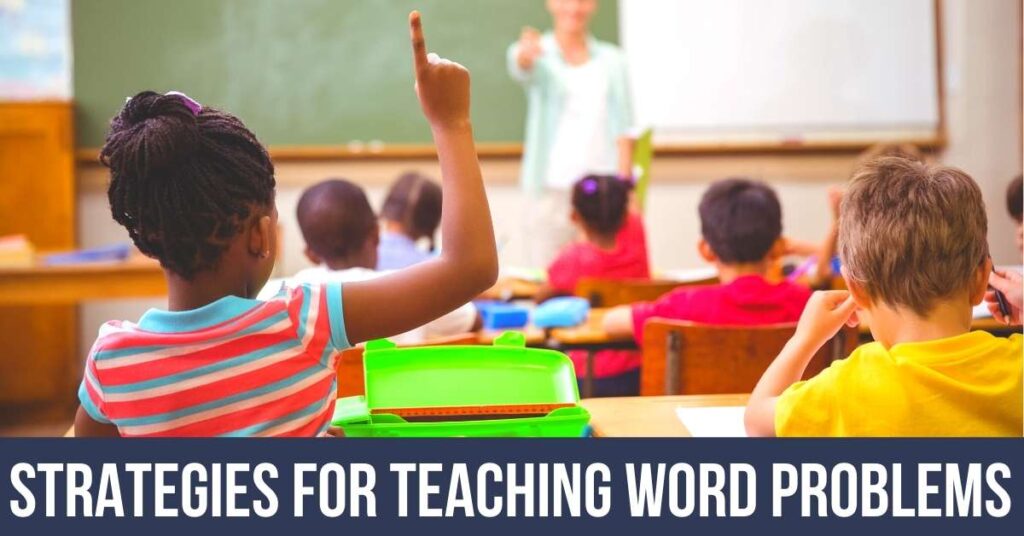
What is a Word Problem?
A word problem is a math situation that calls for an equation to be solved. Students must apply their critical thinking skills to determine how to solve the problem. Word problems give students the opportunity to practice turning situations into numbers. This is critical as students progress in their education, as well as in their day-to-day life. By teaching students how to solve word problems in a strategic way, you are setting them up for future success!
What is a Multi-Step Word Problem?
A multi-step word problem, also known as a two-step word problem or two-step equation word problem, is a math situation that involves more than one equation having to be answered in order to solve the ultimate question. This requires students to apply their problem solving skills to determine which operation or operations to use to tackle the problem and find the necessary information. In some cases, the situation may call for mixed operations, and in others the operations will be the same. Multi-step word problems offer students the opportunity to practice the skill of applying different math concepts with a given problem.

Why are Word Problems Important in Math?
Word problems are essential in math because they give students the opportunity to apply what they have learned to a real life situation. In addition, it facilitates students in developing their higher order thinking and critical thinking skills, creativity, positive mindset toward persevering while problem solving, and confidence in their math abilities. Word problems are an effective tool for teachers to determine whether or not students understand and can apply the concepts and skills they learned to a real life situation.
Why do Students Struggle with Math Word Problems?
Knowing why students have trouble with word problems will help you better understand how to teach them. The reason why math word problems are difficult for your students is because of a few different reasons. First, students need to be able to fluently read and comprehend the text. Second, they need to be able to identify which operations and steps are needed to find the answer. Finally, they need to be able to accurately calculate the answer. If you have students who struggle with reading or English is their second language (ESL), they may not be able to accurately show what they know and can do because of language and literacy barriers. In these cases, it is appropriate to read the text aloud to them or have it translated into their native language for assignments and assessments.

Types of Word Problems
Knowing the different types of word problems will help you better understand how to teach math word problems. Read below to learn about the four types of basic one-step addition and subtraction word problems, the subcategories within each of them, and specific examples for all of them. Two-step equation word problems can encompass two of the same type or two separate types (also known as mixed operation word problems).
1. Join
This type of word problem involves an action that increases the original amount. There are three kinds: Result unknown, change unknown, and initial quantity unknown.
Result Unknown
Example: There were 7 kids swimming in the pool. 3 more kids jumped in. How many kids are in the pool now? (7 + 3 = ?)
Change Unknown
Example: There were 8 kids swimming in the pool. More kids jumped in. Now there are 15 kids in the pool. How many kids jumped in? (8 + ? = 15)
Initial Quantity Unknown
Example: There were kids swimming in the pool. 2 kids jumped in. Now there are 6 kids in the pool. How many kids were swimming in the pool at first? (? + 2 = 6)
2. Separate
This type of word problem involves an action that decreases the original amount. There are three kinds: Result unknown, change unknown, and initial quantity unknown.
Result Unknown
Example: There were 12 kids swimming in the pool. 6 of the kids got out of the pool. How many kids are in the pool now? (12 – 6 = ?)
Change Unknown
Example: There were 9 kids swimming in the pool. Some of the kids got out of the pool. Now there are 4 kids in the pool. How many kids got out of the pool? (9 – ? = 4)
Initial Quantity Unknown
Example: There were kids swimming in the pool. 3 of the kids got out of the pool. Now there are 2 kids in the pool. How many kids were in the pool at first? (? – 3 = 2)
 |  |  |
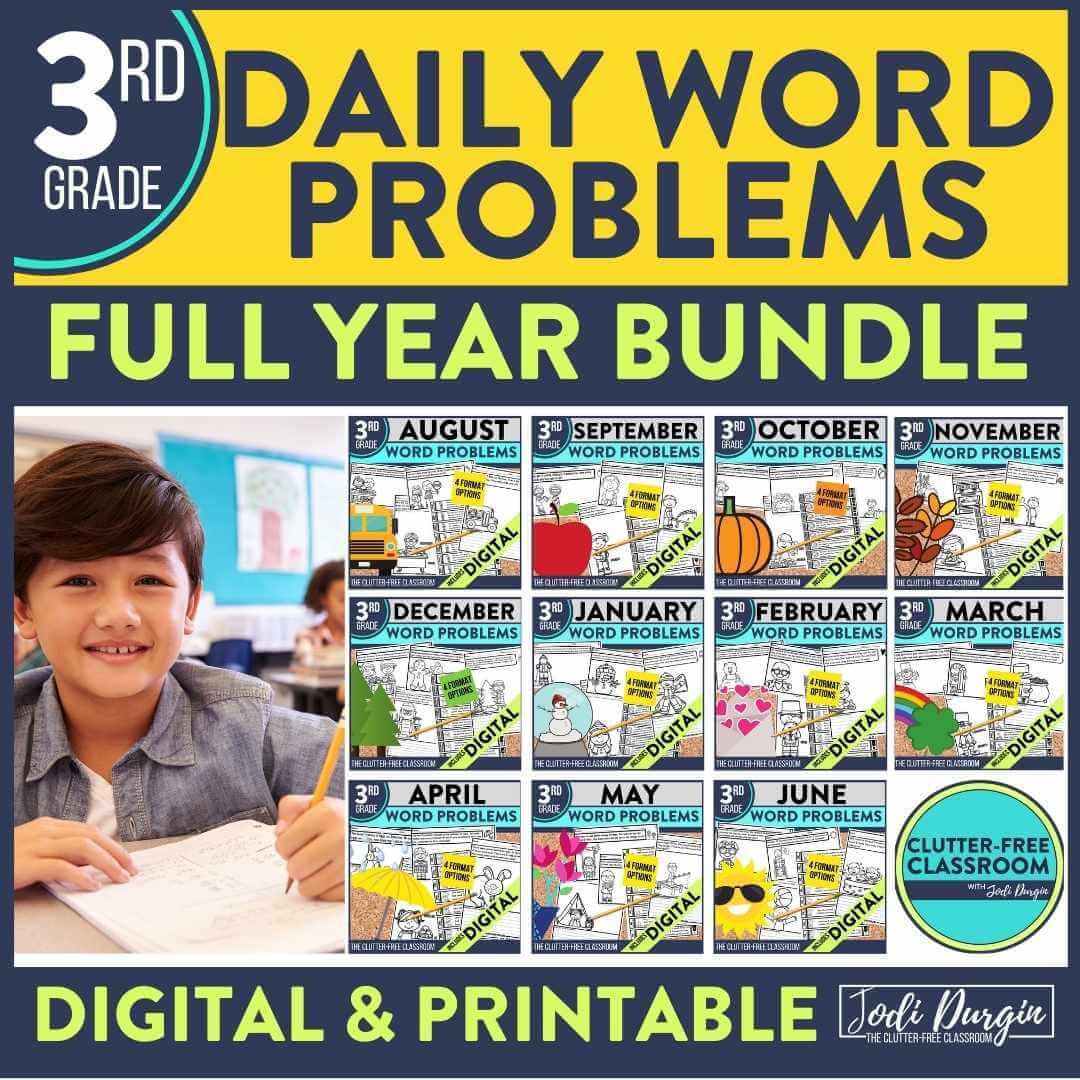 |  |  |
3. Part-Part-Whole
This type of word problem does not involve an action like the join and separate types. Instead, it is about defining relationships among a whole and two parts. There are two kinds: result unknown and part unknown.
Result Unknown
Example: There are 5 boys and 9 girls swimming in the pool. How many kids are in the pool? (5 + 9 = ?)
Part Unknown
Example: There are 12 kids swimming in the pool. 8 of them are girls and the rest of them are boys. How many boys are swimming in the pool? (8 + ? = 12)
4. Compare
This type of word problem does not involve an action or relationship like the three other types. Instead, it is about comparing two different unrelated items. There are two kinds: Difference unknown and quantity unknown.
Difference Unknown
Example: There are 2 kids in the pool. There are 7 kids in the yard. How many more kids are in the yard than in the pool? (2 + ? = 7 or 7 – 2 = ?)
Quantity Unknown
Example 1: There are 5 kids in the pool. There are 3 fewer kids playing in the yard. How many kids are playing in the yard? (5 – 3 = ?)
Example 2: There are 2 kids in the pool. There are 10 more kids playing in the yard than in the pool. How many kids are playing in the yard? (2 + 10 = ?)
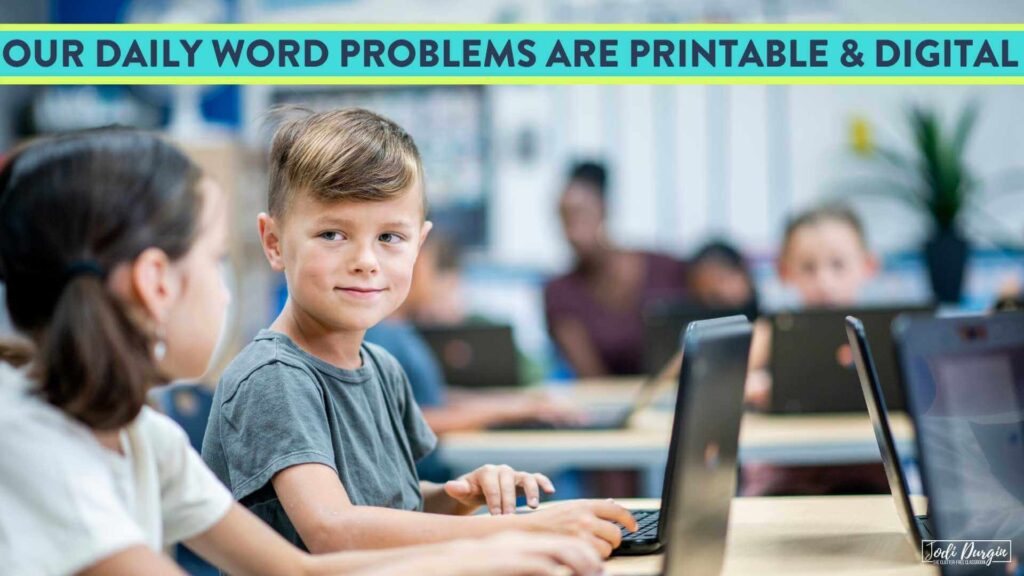
How to Solve Word Problems in 5 Easy Steps
Here are 5 steps that will help you teach word problems to your 1st, 2nd, 3rd, 4th or 5th grade students:
- Read the problem.
- Read the problem a second time and make meaning of it by visualizing, drawing pictures, and highlighting important information (numbers, phrases, and questions).
- Plan how you will solve the problem by organizing information in a graphic organizer and writing down equations and formulas that you will need to solve.
- Implement the plan and determine answer.
- Reflect on your answer and determine if it is reasonable. If not, check your work and start back at step one if needed. If the answer is reasonable, check your answer and be prepared to explain how you solved it and why you chose the strategies you did.
5 Math Word Problem Strategies
Here are 5 strategies for how to teach elementary word problems:
Visualize
Understand the math situation and what the question is asking by picturing what you read in your head while you are reading.
Draw Pictures
Make meaning of what the word problem is asking by drawing a picture of the math situation.
Make Models
Use math tools like base-ten blocks to model what is happening in the math situation.
Highlight Important Information
Underline or highlight important numbers, phrases, and questions.
Engage in Word Study
Look for key words and phrases like “less” or “in all.” Check out this blog post if you are interested in learning more about math word problem keywords and their limitations.
10 Tips for Teaching Students How to Solve Math Word Problems
Here are 10 tips for how to teach math word problems:
- Model a positive attitude toward word problems and math.
- Embody a growth mindset.
- Model! Provide plenty of direct instruction.
- Give lots of opportunities to practice.
- Explicitly teach strategies and post anchor charts so students can access them and remember prior learning.
- Celebrate the strategies and process rather than the correct answer.
- Encourage students to continue persevering when they get stuck.
- Invite students to act as peer tutors.
- Provide opportunities for students to write their own word problems.
- Engage in whole-group discussions when solving word problems as a class.

Common Misconceptions and Errors When Students Learn How to Solve Math Word Problems
Here are 5 common misconceptions or errors elementary students have or make surrounding math word problems:
1. Use the Incorrect Operation
Elementary students often apply the incorrect operations because they pull the numbers from a word problem and add them without considering what the question is asking them or they misunderstand what the problem is asking. Early in their experience with word problems, this strategy may work most of the time; however, its effectiveness will cease as the math gets more complex. It is important to instruct students to develop and apply problem-solving strategies.
Although helpful in determining the meaning, elementary students rely solely on key words and phrases in a word problem to determine what operation is being called for. Again, this may be an effective strategy early on in their math career, but it should not be the only strategy students use to determine what their plan of attack is.
2. Get Stuck in a Fixed Mindset
Some elementary students give up before starting a word problem because they think all word problems are too hard. It is essential to instill a positive mindset towards math in students. The best way to do that is through modeling. If you portray an excitement for math, many of your students will share that same feeling.
3. Struggle with Reading Skills Component
For first and second graders (as well as struggling readers and ESL students), it is common for students to decode the text incorrectly. Along the same lines, some elementary students think they can’t solve word problems because they do not know how to read yet. The purpose of word problems is not to assess whether a child can read or not. Instead, the purpose is to assess their critical thinking and problem-solving skills. As a result, it is appropriate to read word problems to elementary students.
4. Calculate Incorrectly
You’ll find instances where students will understand what the question is asking, but they will calculate the addends or the subtrahend from the minuend incorrectly. This type of error is important to note when analyzing student responses because it gives you valuable information for when you plan your instruction.
5. Encode Response Incorrectly
Another error that is important to note when analyzing student responses is when you find that they encode their solution in writing incorrectly. This means they understand what the problem is asking, they solve the operations correctly, document their work meticulously, but then write the incorrect answer on the line.
How to Address Common Misconceptions Surrounding Math Word Problems
You might be wondering, “What can I do in response to some of these misconceptions and errors?” After collecting and analyzing the data, forming groups based on the results, and planning differentiated instruction, you may want to consider trying out these prompts:
- Can you reread the question aloud to me?
- What is the question asking us to do?
- How can we represent the information and question?
- Can we represent the information and question with an equation?
- What is our first step?
- What is our next step?
- Can you think of any strategies we use to help us solve?
- How did you find your answer?
- Can you walk me through how you found your answer step by step?
- What do we need to remember when recording our answer?

Now that you have all these tips and ideas for how to teach word problems, we would love for you to try these word problem resources with your students. They offer students opportunities to practice solving word problems after having learned how to solve word problems. You can download word problem worksheets specific to your grade level (along with lots of other math freebies) in our free printable math resources bundle using this link: free printable math activities for elementary teachers.
Check out my monthly word problem resources!
- 1st Grade Word Problems
- 2nd Grade Word Problems
- 3rd Grade Word Problems
- 4th Grade Word Problems
- 5th Grade Word Problems



